
Verrucariaceae is a family of lichens and a few non-lichenised fungi in the order Verrucariales. The lichens have a wide variety of thallus forms, from crustose (crust-like) to foliose (bushy) and squamulose (scaly). Most of them grow on land, some in freshwater and a few in the sea. Many are free-living but there are some species that are parasites on other lichens, while one marine species always lives together with a leafy green alga.

Endocarpon is a genus of saxicolous (rock-dwelling), crustose lichens in the family Verrucariaceae. The genus was circumscribed by German bryologist Johann Hedwig in 1789.

Dermatocarpon is a genus of lichens in the family Verrucariaceae.
Clavascidium is a genus of lichens in the family Verrucariaceae. The genus was circumscribed in 1996 by Austrian lichenologist Othmar Breuss. Because the type species of the genus, Clavascidium umbrinum, has been shown using molecular phylogenetics to belong to genus Placidium, Cécile Gueidan and colleagues proposed to unite Clavascidium with Placidium in a 2009 publication. Despite this, the genus has been retained in recent publications of fungal classification.
Clauzadella is a genus of fungi in the family Verrucariaceae. A monotypic genus, it contains the single species Clauzadella gordensis, discovered in France and described as new to science in 1996 by Pere Navarro-Rosinés and Claude Roux.

Catapyrenium is a genus of lichens in the family Verrucariaceae. The genus was circumscribed by German botanist Julius von Flotow in 1850.
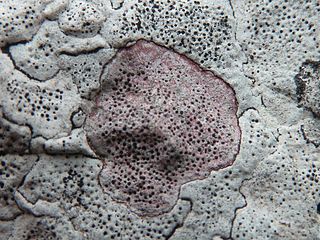
Bagliettoa is a genus of lichen-forming fungi in the family Verrucariaceae. The genus was circumscribed by Italian lichenologist Abramo Bartolommeo Massalongo in 1853. Bagliettoa species are endolithic, growing between the grains of solid rock.
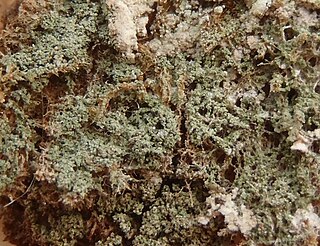
Agonimia is a genus of lichen-forming fungi in the family Verrucariaceae.

Placidium is a genus of crustose to squamulose to almost foliose lichens. The genus is in the family Verrucariaceae. Most members grow on soil, but some grow on rock (saxicolous). The fruiting bodies are perithecia, flask-like structures immersed in the lichen body (thallus) with only the top opening visible, dotting the thallus. Lichen spot tests are all negative. Members of the genus lack rhizines, but otherwise resemble members of the genus Clavascidium.

Placidiopsis is a genus of lichens in the family Verrucariaceae. The genus was circumscribed by Italian naturalist Francesco Beltramini de Casati in 1858, with Placidiopsis grappae assigned as the type species.
Neocatapyrenium is a genus of squamulose lichens in the family Verrucariaceae. It has five species. The genus was circumscribed by Hiroshi Harada in 1993, with Neocatapyrenium cladonioideum assigned as the type species.
Involucropyrenium is a genus of lichens in the family Verrucariaceae. It has nine species. The genus was circumscribed by Austrian lichenologist Othmar Breuss in 1996, with Involucropyrenium waltheri assigned as the type species.

Heteroplacidium is a genus of lichen-forming fungi in the family Verrucariaceae. The genus was circumscribed by Austrian lichenologist Othmar Breuss in 1996 with Heteroplacidium imbricatum assigned as the type species. It was proposed as a segregate of Catapyrenium. Other morphologically similar genera are Neocatapyrenium, Placidium, and Scleropyrenium, although molecular phylogenetic analyses indicate that they are independent monophyletic lineages within the Verrucariaceae.
Henrica is a genus of crustose lichens in the family Verrucariaceae. It has four species. The genus was circumscribed by Maurice Bouly de Lesdain in 1921, with Henrica ramulosa assigned as the type species. The generic name Henrica honours Italian clergyman and lichenologist Joseph-Marie Henry (1870–1947).
Polyblastia is a genus of lichenized fungi in the family Verrucariaceae. As of 2020, it consists of about 40 species combined with about 50 orphaned species. The main difference with the genus Verrucaria is related to spores, which are muriform in Polyblastia.
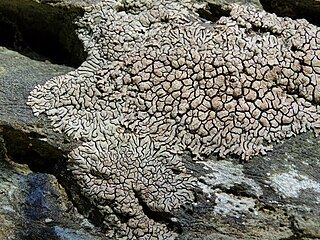
Placopyrenium is a genus of saxicolous (rock-dwelling), crustose lichens in the family Verrucariaceae.
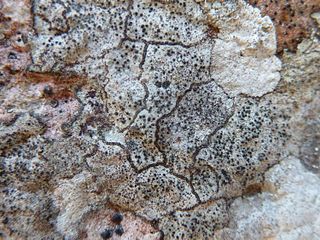
Parabagliettoa is a genus of crustose lichens in the family Verrucariaceae. It has 3 species. The genus was circumscribed in 2009 by Cécile Gueidan and Claude Roux, with Parabagliettoa dufourii assigned as the type species.
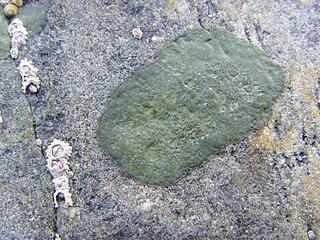
Wahlenbergiella is a genus of saxicolous (rock-dwelling), crustose lichens in the family Verrucariaceae. It has three species, all of which live in marine intertidal zones where they get periodically immersed in seawater. Wahlenbergiella closely resembles another lichen genus that includes marine species, Hydropunctaria. Wahlenbergiella was circumscribed in 2009 by Cécile Gueidan and Holger Thüs. They initially included two species: W. striatula, and the type,W. mucosa. The generic name honours Swedish naturalist Göran Wahlenberg, who originally described both of these species.
Trimmatothele is a genus of saxicolous (rock-dwelling), crustose lichens in the family Verrucariaceae. It has five species. The genus was formally published by lichenologist Alexander Zahlbruckner in 1903. The type species, Trimmatothele perquisita, was originally collected from Norway by Johannes M. Norman, who placed it in the genus Coniothele in 1868. Diagnostic characteristics of Trimmatothele include a thin thallus with a smooth surface; small perithecia that are partially immersed in the substrata and have an involucrellum; asci that contain multiple ascospores; and small, simple ascospores. Trimmatothele has been described as one of the most poorly known genera of lichens due to the rarity of its species, the few available herbarium specimens, and some missing type specimens.

Catapyrenium boccanum is a species of squamulose (scaley), rock-dwelling lichen in the family Verrucariaceae. It grows on mortar or on calcareous rock. Its squamules are up to 4 mm wide, pale to dark brown with black margins and a black underside. Ascospores measure 11–15 by 5–8 μm. Because of its combination of squamulose thallus, simple ascospores, and lack of algae in the hymenium, this species is a "catapyrenioid" lichen, of which more than 80 exist in the Verrucariaceae.













